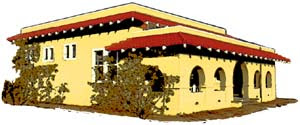The Mojave Desert Archives is housed in the Dennis G. Casebier Library, a state-of-the-art archival repository built in the image of the historic Goffs Santa Fe Railway Depot (1902-1956). This 6,000 square-foot building was made possible by a grant from the California Cultural and Historical Endowment and the membership of the Mojave Desert Heritage and Cultural Association (MDHCA).
The entrance to the Library is through the green door, just to the right of the old baggage cart and platform (below) in the two-story part of the building.
Upon entering the Library Reading Room, visiting researchers are greeted by staff and provided with an orientation on Archives rules and procedures. The large library table (below) is is where the researcher will set up, receive requested materials, and conduct their study. (Click on image to see full-size)
This wide view of the Reading Room (below) shows the location of the staff station on the right side of the room. The microfilm reader station is located in between the library table (center) and the staff station. Bookcases containing oral history transcripts and reference books line the walls.
Between the microfilm reader and staff stations is the Archives Citation bookcase. There are more than 130 titles assembled on the shelves in which the Mojave Desert Archives are referenced. The types of publications making up this collection are scholarly theses, historical monographs, government reports, and the in-house publications of the MDHCA. This output is the most visible representation of how the Mojave Desert Archives gives back to our community.
Inside the low and long one-story portion of the Library building, called the Freight House, is where the stacks of the repository are stored. The Freight House is divided into two equally sized rooms. Below is the north room. The file cabinets contain our Subject Files, processed manuscript collections, microfilm, pamphlets, and periodicals, such as a full set of Desert Magazine.
The north room has a scanning station for photographic and microform materials (below). This equipment is typically used to fulfill reference requests for long-distance researchers.
The north Freight House also houses the server rack for the Archives (below). This system runs ArchivesSpace, a web-based archives information management system, used to organize the collections of the Mojave Desert Archives and to develop collection guides for upload to the Online Archive of California. The digital assets of the collections are also preserved and backed up here. [Systems gifted by Smile Brands, Inc., Irvine, California.]
The north Freight House is also home to a small exhibit of framed photographic enlargements from the O. A. Russell Photograph Collection and vintage World War I and II war bond posters.
Interpretive graphic for the O. A. Russell photo exhibit (below).
The south Freight House contains both processed and unprocessed collections. The record storage racks (below) contain accessioned materials that are awaiting arrangement and description. The major collections stored here are those of desert writers Harold and Lucile Weight, San Bernardino County researcher Germaine Moon, and desert land activist Hildamae Voght.
The long tables in the lower right portion of the image below provide an excellent work space for handling oversized materials or for beginning the process of organizing materials from the record storage boxes.
The south Freight House is also home to flat files containing the 7,000 historical maps of the Mojave Desert Archives.
We hope you have enjoyed this virtual tour of the Mojave Desert Archives. In-person tours are typically led by the Archivist at the annual Mojave Road Rendezvous, held at the Goffs Cultural Center in early fall. Thank you!
Thursday, February 2, 2017
Subscribe to:
Posts (Atom)















